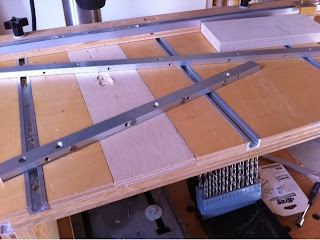I've said before that jigs need three things: A good way to position the stock in alignment, a good way to hold it in alignment, and an accurate way to guide the stock past the cutter.
I've been generally frustrated with store bought miter bars for use in jigs. They suck. Period. And the reason that's such a problem is that they're the foundation for any jig you'll make. Any effort you put into making accurate fences, or solid work holding, will be undermined by the fact that you can't move the jig past the cutter in a way that's accurate enough.
There's a basic problem that manufacturers have: they don't know the exact width of YOUR miter slot. Most are 3/4". But that's ballpark, and subject to error. The only solution accessory manufacturers have is, make sure your error margin is greater. So, stock bars, like the one in the photo, are generally shy by a full 1/64". Longer bars will theoretically reduce the slop in the angle, but they still aren't great. And the goofy plastic shimming measures all share a common problem: They're plastic, and subject to wear from use, or damage from day to day bounces in and out of a machined cast iron surface. The end result is that there's a decent chance that, even with a ridiculously accurate miter gauge or sled, when the stars (and plastic afterthoughts) aren't in rare alignment, your joints will have gaps that don't need to be there.
This is a chunk of Kreg bar, drilled, tapped, and countersunk for steel screws. The tap I used was chosen because it's worn, so the threads are a little snug. That way they'll hold an adjustment better. There's zero slop in the miter track, now that it's properly adjusted. It's not my ideal solution, but it's miles ahead of what I had to work with before.

No comments:
Post a Comment